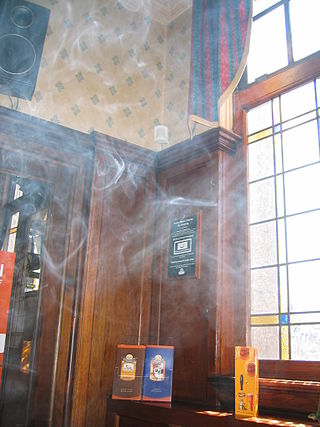
Nicotine is a naturally produced alkaloid in the nightshade family of plants and is widely used recreationally as a stimulant and anxiolytic. As a pharmaceutical drug, it is used for smoking cessation to relieve withdrawal symptoms. Nicotine acts as a receptor agonist at most nicotinic acetylcholine receptors (nAChRs), except at two nicotinic receptor subunits where it acts as a receptor antagonist.

Smoking cessation, usually called quitting smoking or stopping smoking, is the process of discontinuing tobacco smoking. Tobacco smoke contains nicotine, which is addictive and can cause dependence. As a result, nicotine withdrawal often makes the process of quitting difficult.

Luther Leonidas Terry was an American physician and public health official. He was appointed the ninth Surgeon General of the United States from 1961 to 1965, and is best known for his warnings against the dangers and the impact of tobacco use on health.

Passive smoking is the inhalation of tobacco smoke, commonly called secondhand smoke (SHS) or environmental tobacco smoke (ETS), by persons other than the active smoker. It occurs when tobacco smoke diffuses into the surrounding atmosphere as an aerosol pollutant, which leads to its inhalation by nearby bystanders within the same environment. Exposure to secondhand tobacco smoke causes many of the same diseases caused by active tobacco smoking, although to a lower prevalence due to the reduced concentration of smoke that enters the airway. The health risks of secondhand smoke are a matter of scientific consensus, and have been a major motivation for smoke-free laws in workplaces and indoor venues, including restaurants, bars and night clubs, as well as some open public spaces.

Cotinine is an alkaloid found in tobacco and is also the predominant metabolite of nicotine. An anagram of the word "nicotine", it is used as a biomarker for exposure to tobacco smoke. Cotinine is currently being studied as a treatment for depression, post-traumatic stress disorder (PTSD), schizophrenia, Alzheimer's disease and Parkinson's disease. Cotinine was developed as an antidepressant as a fumaric acid salt, cotinine fumarate, to be sold under the brand name Scotine but it was never marketed.

Nicotine replacement therapy (NRT) is a medically approved way to treat people with tobacco use disorder by taking nicotine through means other than tobacco. It is used to help with quitting smoking or stopping chewing tobacco. It increases the chance of quitting tobacco smoking by about 55%. Often it is used along with other behavioral techniques. NRT has also been used to treat ulcerative colitis. Types of NRT include the adhesive patch, chewing gum, lozenges, nose spray, and inhaler. The use of multiple types of NRT at a time may increase effectiveness.

The Public Health Cigarette Smoking Act is a 1970 federal law in the United States designed to limit the practice of tobacco smoking. As approved by the United States Congress and signed into law by President Richard Nixon, the act required a stronger health warning on cigarette packages, saying "Warning: The Surgeon General Has Determined that Cigarette Smoking Is Dangerous to Your Health". It also banned cigarette advertisements on American radio and television.

The Comprehensive Smoking Education Act of 1984 is an act of the Congress of the United States. A national program established in order to improve the availability of information on health risks related to tobacco smoking, to amend the Federal Cigarette Labeling and Advertising Act so that cigarette warning labels would be different, and for other reasons, the Comprehensive Smoking Education Act was enacted with a purpose to, as stated in Section 1 of the Act, "provide a new strategy for making Americans more aware of any adverse health effects of smoking, to assure the timely and widespread dissemination of research findings and to enable individuals to make informed decisions about smoking". Adopted by Congress in 1984 and effective October 12, 1984, the Comprehensive Smoking Education Act created a rotational warning system that required all cigarette packages and advertisements to rotate the following four warnings every three months:

Tobacco products, especially when smoked or used orally, have negative effects on human health, and concerns about these effects have existed for a long time. Research has focused primarily on cigarette smoking.

A menthol cigarette is a cigarette flavored with the compound menthol.

A Frank Statement to Cigarette Smokers was a historic first advertisement in a campaign run by major American tobacco companies on January 4, 1954, to create doubt by disputing recent scientific studies linking smoking cigarettes to lung cancer and other dangerous health effects.

Tobacco control is a field of international public health science, policy and practice dedicated to addressing tobacco use and thereby reducing the morbidity and mortality it causes. Since most cigarettes and cigars and hookahs contain/use tobacco, tobacco control also concerns these. E-cigarettes do not contain tobacco itself, but (often) do contain nicotine. Tobacco control is a priority area for the World Health Organization (WHO), through the Framework Convention on Tobacco Control. References to a tobacco control movement may have either positive or negative connotations, depending upon the commentator.

Tobacco smoking has serious negative effects on the body. A wide variety of diseases and medical phenomena affect the sexes differently, and the same holds true for the effects of tobacco. Since the proliferation of tobacco, many cultures have viewed smoking as a masculine vice, and as such the majority of research into the specific differences between men and women with regards to the effects of tobacco have only been studied in-depth in recent years.
The majority of lifelong smokers begin smoking habits before the age of 24, which makes the college years a critical time for tobacco companies to convince college students to pick up the habit of cigarette smoking. Cigarette smoking in college is seen as a social activity by those who partake in it, and more than half of the students that are users do not consider themselves smokers. This may be because most college students plan to quit smoking by the time that they graduate.
The use of electronic cigarettes (vaping) carries health risks. The risk depends on the fluid and varies according to design and user behavior. In the United Kingdom, vaping is considered by some to be around 95% less harmful than tobacco after a controversial landmark review by Public Health England.
The scientific community in United States and Europe are primarily concerned with the possible effect of electronic cigarette use on public health. There is concern among public health experts that e-cigarettes could renormalize smoking, weaken measures to control tobacco, and serve as a gateway for smoking among youth. The public health community is divided over whether to support e-cigarettes, because their safety and efficacy for quitting smoking is unclear. Many in the public health community acknowledge the potential for their quitting smoking and decreasing harm benefits, but there remains a concern over their long-term safety and potential for a new era of users to get addicted to nicotine and then tobacco. There is concern among tobacco control academics and advocates that prevalent universal vaping "will bring its own distinct but as yet unknown health risks in the same way tobacco smoking did, as a result of chronic exposure", among other things.
The 1950 Wynder and Graham Study was conducted by Ernest Wynder and Evarts Graham and was entitled "Tobacco Smoking as a Possible Etiologic Factor in Bronchiogenic Carcinoma: A Study of Six Hundred and Eighty-Four [684] Proved Cases". It was published on May 27, 1950. It was a case-control study to determine the relationship between various external factors and the development of bronchogenic carcinoma. The study concluded that long-term tobacco usage contributes to the onset of lung cancer, as an overwhelming majority (96.5%) of the men with the disease were classified as moderate to heavy smokers for an extended period of time, compared to a lower percentage of the general hospital population control group.
Exposure to nicotine, from conventional or electronic cigarettes during adolescence can impair the developing human brain. E-cigarette use is recognized as a substantial threat to adolescent behavioral health. The use of tobacco products, no matter what type, is almost always started and established during adolescence when the developing brain is most vulnerable to nicotine addiction. Young people's brains build synapses faster than adult brains. Because addiction is a form of learning, adolescents can get addicted more easily than adults. The nicotine in e-cigarettes can also prime the adolescent brain for addiction to other drugs such as cocaine. Exposure to nicotine and its great risk of developing an addiction, are areas of significant concern.

Emily Banks is an epidemiologist and public health physician, working mainly on chronic disease. She is a Professor of Epidemiology and Public Health and Head of the Centre for Public Health Data and Policy at the Australian National University, and a visiting professor at the University of Oxford.

Brian King is an American Epidemiologist who currently serves as the Director of the Food and Drug Administration’s Center for Tobacco Products (CTP). He was appointed to his role in July of 2022.














